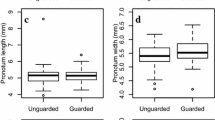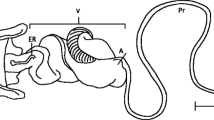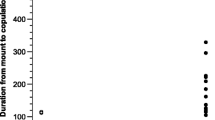Summary
A recent model in sexual selection has proposed a role for parasites in maintaining heritable fitness variation. Females are envisaged as benefitting from preferentially mating with males that show resistance to infection. The post-copulatory guarding behaviour characteristic of many species of field cricket, has been envisaged as a means by which females assess male health and vigour. This hypothesis was tested in a field cricket, G. bimaculatus, which harbours a protozoan gut parasite. In enclosed arena trials, no direct correlations between female behaviours and levels of infection in males were found. However, there were significant correlations between the intensity of male guarding and the number of parasites found in the gut; infected males guarded more intensely in order to maintain contact with the female. In a second experiment simulating open field conditions, females left heavily parasitized males sooner than mildly or uninfected individuals. These data are discussed in relation to female choice for male health and vigour.
Similar content being viewed by others
References
Anderson RM, Gordon DM (1982) Processes influencing the distribution of parasite numbers within host populations with special emphasis on parasite-induced host mortality. Parasitology 85:373–398
Bateson P (1983) Mate choice. Cambridge University Press, Cambridge
Dawkins R (1982) The extended phenotype. The gene as the unit of selection. Freeman, Oxford
Falconer DS (1981) Introduction to quantitative genetics, 2nd edn., Longman, London
Fisher RA (1930) The genetic theory of natural selection, 2nd edn. Oxford University Press, Oxford
Hamilton WD, Zuk M (1982) Heritable true fitness and bright birds: a role for parasites? Science 218:384–387
Loher W, Renee B (1978) The mating behaviour of Teleogryllus commodus (Walker) and its central and peripheral control. Z Tierpsychol 46:225–259
Moore J (1983) Altered behaviour in cockroaches (Periplaneta americana) infected with an archiacanthocephalan Moniliformis moniliformis. J Parasitol 69:1174–1177
Moore J (1984) Altered behavioural responses in intermediate hosts: an acanthocephalan parasite strategy. Am Nat 123:572–577
Nagao T, Shimozawa T (1987) A fixed time-interval between two behavioural elements in the mating behaviour of male crickets, Gryllus bimaculatus. Anim Behav 35:122–130
Parker GA (1983) Mate quality and mating decisions. In: Bateson P (ed) Mate choice. Cambridge University Press, Cambridge, pp 141–166
Rice WR (1989) Analyzing tables of statistical tests. Evolution 43:223–225
Sakaluk SK, Cade WH (1980) Female mating frequency and progeny production in singly and doubly mated house and field crickets. Can J Zool 58:404–411
Simmons LW (1986) Female choice in the field cricket, Gryllus bimaculatus (de Geer). Anim Behav 34:1463–1470
Simmons LW (1987 a) Sperm competition as a mechanisms of female choice in the field cricket, Gryllus bimaculatus. Behav Ecol Sociobiol 21:197–202
Simmons LW (1987 b) Competition between larvae of the field cricket, Gryllus bimaculatus (Orthoptera: Gryllidae) and its effects on some life history components of fitness. J Anim Ecol 56:1015–1027
Simmons LW (1987 c) Female choice contributes to offspring fitness in the field cricket, Gryllus bimaculatus (de Geer). Behav Ecol Sociobiol 21:313–321
Simmons LW (1988 a) The calling song of the field cricket, Gryllus bimaculatus (de Geer): constraints on transmission and its role in intermale competition and female choice. Anim Behav 36:380–394
Simmons LW (1988 b) Male size, mating potential and lifetime reproductive success in the field cricket, Gryllus bimaculatus (de Geer). Anim Behav 36:372–379
Simmons LW (1989) Kin-recognition and its influence on mating preferences of the field cricket, Gryllus bimaculatus (de Geer). Anim Behav 37:68–77
Smyth JD (1976) Introduction to animal parasitology, Hodder and Stoughton, London
Waage J (1984) Sperm competition and the evolution of Odonate mating systems. In: Smith RL (ed) Sperm competition and the evolution of animal mating systems. Academic Press, London, pp 251–290
Wilson K, Edwards J (1986) The effects of parasitic infection on the behaviour of an intermediate host, the American cockroach, Periplaneta americana, infected with the acanthocephalan, Moliniformis moniliformis. Anim Behav 34:942–944
Zuk M (1987 c) The effects of gregarine parasites, body size, and time of day on spermatophore production and sexual selection in field crickets. Behav Ecol Sociobiol 21:65–72
Zuk M (1987 b) Seasonal and individual variation in gregarine parasite levels in the field crickets Gryllus veletis and G. pennsylvanicus. Ecol Entomol 12:341–348
Zuk M (1987 c) The effects of gregarine parasites on longevity, weight loss, fecundity and development time in the field crickets Gryllus veletis and G. pennsylvanicus. Ecol Entomol 12:349–354
Author information
Authors and Affiliations
Rights and permissions
About this article
Cite this article
Simmons, L.W. Post-copulatory guarding, female choice and the levels of gregarine infections in the field cricket, Gryllus bimaculatus . Behav Ecol Sociobiol 26, 403–407 (1990). https://doi.org/10.1007/BF00170897
Received:
Accepted:
Issue Date:
DOI: https://doi.org/10.1007/BF00170897




